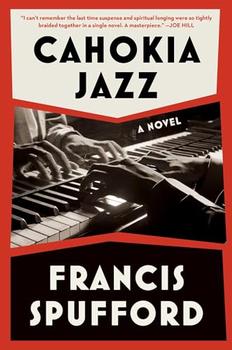Reading Guide Questions

Please be aware that this discussion guide will contain spoilers!
-
The novel begins by quoting a fictionalized Better Business Bureau guide to the city of Cahokia about the terms that denote the three major groups in its population: the takouma, the taklousa, and the takata. How does this immerse us in the world within Cahokia Jazz, and how does it differ from our world? What is the significance of different racial and ethnic titles in this world compared to ours?
- Examine cultural identity and cultural mixture in the novel. How does Barrow handle this and how does the world perceive him? What world events caused this city to form? How is this true also to many people's experiences in our world?
- When Barrow and Drummond investigate the murder victim on the skyscraper, we learn a bit about the language that illustrates how our characters navigate their world. How does the Anopa language shape the novel, and what are some of the most interesting vernacular moments in this story?
- When Barrow meets Sebastian Cuauhtemoc Hashi, "the Man of the Sun," and begins to learn about the Hashi dynasty, he has many concerns: the Man's request, his display of power, and the family's wealth. The city's businesses, government, and police force also have their hesitations about the Hashi family and its bloodline. Why is Barrow concerned about the Hashis' interest in the murder victim and their grand role in the case? Are Barrow's suspicions justified?
- The Man says the following to Barrow: "Symbolism, you see, detective. It has consequences. It gives a nudge to the world. It makes things happen" (page 31). What symbols are present throughout the work?
- Why are Drummond and Barrow friends? Are Drummond and Barrow friends?
- At one point in the novel, Drummond says to Barrow: "It's all a racket, Joe, everywhere you look, and the only way not to be a sucker is, believe none of it. Free your mind. Free—your—mind" (page 49). What does this say about Drummond's character, and does Barrow follow this advice? How does Drummond's cynicism reflect the world in this novel? Is he right?
- The themes and pacing of this narrative are heavily influenced by the noir genre: undercover conspiracies, jazz, detective twists, and many more. What elements of noir do you see in this work? How does the story play with genre conventions and subvert them?
- Who is Peggy Iti/Sister Peggy? What does she do? Compare her with the other women in the novel. How does she shake up societal norms and push back against the patriarchal structures that Barrow and the others are familiar with?
- Describe Barrow's encounter with Couma Hashi at the Catawba Room. What does she mean when she tells Barrow that she envies him? How does this hint at Couma Hashi's character and motives throughout the novel?
- Barrow wears many masks throughout this story: that of a jazz pianist, a detective, a person of uncertain race who walks between the multiple power structures in Cahokia. How does his life as a former full-time artist influence his role as a detective? How does his mixed inheritance influence how takouma, taklousa, and takata people view him?
- How does the story tease at Drummond and Barrow's end? What clues are placed throughout the story to reach this conclusion?
- Discuss the world-building in this novel. What made this setting unique for you? Did you believe in it as a possible course for American history?
- Who is "Professor Kroeber's daughter," and why do you think Cahokia Jazz is dedicated to her? How many other walk-on appearances by real historical figures can you spot in the different parts of the book?
- The year 1922 is a century ago, far off in time, and the book is not even set in the 1922 of our own American history. Still, what similarities might you notice between the world of the book and the world of the present day?
- Why do you think the book is called Cahokia Jazz? How does the eclectic musical art form of jazz help tell the tale?
- After reading the book, check out the notes and acknowledgements. What are some of the most interesting takeaways from the author's research and notes?
Enhance Your Book Club
- Read Francis Spofford's novel Golden Hill, an alternate history of eighteenth-century New York. What similarities exist between the two novels, and how are they different?
- Explore St. Louis, Missouri, and the area where Cahokia would have been. What are some aspects of St. Louis that influenced the city of Cahokia?
Unless otherwise stated, this discussion guide is reprinted with the permission of Scribner.
Any page references refer to a USA edition of the book, usually the trade paperback version, and may vary in other editions.

 Book Reviewed by:
Book Reviewed by:





